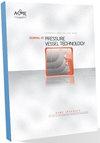外磁场对压力容器钢(Sa 516 70级)钨极气体保护焊焊缝力学性能和冶金性能的影响
IF 1.4
4区 工程技术
Q4 ENGINEERING, MECHANICAL
Journal of Pressure Vessel Technology-Transactions of the Asme
Pub Date : 2023-08-03
DOI:10.1115/1.4063096
引用次数: 0
摘要
焊缝的力学和冶金性能对焊缝的性能起着最重要的作用,需要提高焊缝的性能。将外磁场叠加到焊接电弧上,为改善焊缝的形状和性能提供了良好的效果。在本研究中,使用不同配置的专门设计的电磁铁来研究它们对SA 516 70级焊缝特性的影响。与其他配置以及传统的钨极气体保护焊(GTAW)工艺相比,0-0-S-N配置产生了最大熔深(3.92mm)。通过拉伸试验、夏比冲击试验和显微硬度试验研究了焊缝的力学性能,并通过显微组织分析确定了焊缝的冶金性能。结果表明,磁控GTAW(MCGTAW)焊缝的抗拉强度、冲击强度和显微硬度分别为620MPa、275J和198HV,分别比GTAW工艺生产的焊缝高3.16%、22.76%和1.51%。还观察到电磁搅拌细化了熔池的微观结构。MCGTAW焊缝的平均晶粒尺寸为31.035µm,而在传统GTAW焊缝中获得了42.558µm的平均晶粒。电磁搅拌提高了焊接冷却速度,从而形成了更多的针状铁素体,这是所希望的。本文章由计算机程序翻译,如有差异,请以英文原文为准。
Influence Of External Magnetic Field On Mechanical And Metallurgical Properties Of Pressure Vessel Steel (Sa 516 Grade 70) Welds Using Gas Tungsten Arc Welding
The mechanical and metallurgical properties of weld play the most important role in the performance of welds which needs to be enhanced. The superimposing external magnetic field to the welding arc provided wonderful and favourable results for improving the shape and properties of weld. In this research, different configurations of specially designed electromagnets were used to investigate their effects on weld characteristics of SA 516 grade 70 welds. It is observed that 0-0-S-N configuration yielded maximum penetration (3.92 mm) compared with other configurations as well as the conventional gas tungsten arc welding (GTAW) process. Tensile test, Charpy impact test and microhardness were performed to investigate the mechanical properties and microstructure analysis was used to determine the metallurgical properties of the weld joints. The result shows that the tensile strength, impact strength, and microhardness of magnetically controlled GTAW (MCGTAW) weld was 620MPa, 275J and 198HV respectively which is 3.16%, 22.76%, and 1.51% higher than weld produced by GTAW process. It has also been observed that electromagnetic stirring refined the microstructure of the weld pool. The average grain size of MCGTAW weld was 31.035µm whereas 42.558µm average grain was obtained in conventional GTAW weld. The electromagnetic stirring enhanced the weld cooling rate resulting formation of more acicular ferrite which is desirable.
求助全文
通过发布文献求助,成功后即可免费获取论文全文。
去求助
来源期刊
CiteScore
2.10
自引率
10.00%
发文量
77
审稿时长
4.2 months
期刊介绍:
The Journal of Pressure Vessel Technology is the premier publication for the highest-quality research and interpretive reports on the design, analysis, materials, fabrication, construction, inspection, operation, and failure prevention of pressure vessels, piping, pipelines, power and heating boilers, heat exchangers, reaction vessels, pumps, valves, and other pressure and temperature-bearing components, as well as the nondestructive evaluation of critical components in mechanical engineering applications. Not only does the Journal cover all topics dealing with the design and analysis of pressure vessels, piping, and components, but it also contains discussions of their related codes and standards.
Applicable pressure technology areas of interest include: Dynamic and seismic analysis; Equipment qualification; Fabrication; Welding processes and integrity; Operation of vessels and piping; Fatigue and fracture prediction; Finite and boundary element methods; Fluid-structure interaction; High pressure engineering; Elevated temperature analysis and design; Inelastic analysis; Life extension; Lifeline earthquake engineering; PVP materials and their property databases; NDE; safety and reliability; Verification and qualification of software.

 求助内容:
求助内容: 应助结果提醒方式:
应助结果提醒方式:


